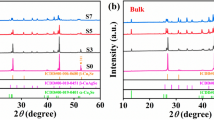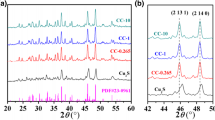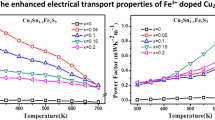Abstract
Recently, thermoelectric (TE) materials have seized great attention for their role in clean energy conversion applications. Cu2S are p-type super-ionic conductors featuring a narrow band gap of 1.7 eV while exhibiting outstanding thermoelectric characteristics. The Cu2S matrix and the CuO nanoinclusions were successfully synthesized via solvothermal and hydrothermal routes, respectively. The morphological observations made through scanning and transmission electron microscope ensured the homogeneous distribution of CuO nanoinclusions in the Cu2S matrix, hence, the formation of standard Cu2S/CuO composites. In this work, we have introduced a “combined strategy” to boost the figure of merit (zT). The Seebeck coefficient reached the maximum of 271.86 μVK−1 at 573 K for the 20 wt% CuO sample (a 71.45% gain when compared to the pure Cu2S) owing to the filtration of low-energy carriers at the CuO potential barriers (2.5 eV). The Cu2S/20 wt% CuO sample achieved the minimum thermal conductivity values. At 573 K, We recorded a vast power factor value of 952.66 μWm−1 K−2 (32.23% gain) for the Cu2S/15 wt% CuO sample. These values are vastly higher than previously reported for the copper sulfides-based TE materials. Consequently, an optimised zT value of 0.44 (214.29% gain) was accomplished for the Cu2S/15 wt% CuO sample at 573 K. The strategy presented in our study can also be extended to other TE materials, especially for the promising copper chalcogenides to improve their zT values.













Similar content being viewed by others
References
G.J. Snyder, E.S. Toberer, Complex thermoelectric materials, in Materials for sustainable energy: a collection of peer-reviewed research and review articles from Nature Publishing Group. (World Scientific, 2011), pp.101–110
Z.-G. Chen et al., Nanostructured thermoelectric materials: current research and future challenge. Prog. Nat. Sci. Mater. Int. 22(6), 535–549 (2012)
Y. Pei et al., Stabilizing the optimal carrier concentration for high thermoelectric efficiency. Adv. Mater. 23(47), 5674–5678 (2011)
C. Zhao et al., Defects engineering with multiple dimensions in thermoelectric materials. Research. 2020, 9652749 (2020)
T.M. Tritt, Thermoelectric phenomena, materials, and applications. Annu. Rev. Mater. Res. 41(1), 433–448 (2011)
X. Zhang, L.-D. Zhao, Thermoelectric materials: energy conversion between heat and electricity. J. Materiomics 1(2), 92–105 (2015)
H. Mamur et al., A review on bismuth telluride (Bi2Te3) nanostructure for thermoelectric applications. Renew. Sustain. Energy Rev. 82, 4159–4169 (2018)
G. Ding et al., High thermoelectric properties of n-type Cd-doped PbTe prepared by melt spinning. Scr. Mater. 122, 1–4 (2016)
G. Zheng et al., Toward high-thermoelectric-performance large-size nanostructured BiSbTe alloys via optimization of sintering-temperature distribution. Adv. Energy Mater. 6(13), 1600595 (2016)
B. Ge et al., Atomic level defect structure engineering for unusually high average thermoelectric figure of merit in n-type pbse rivalling PbTe. Adv. Sci. (Weinh). 9, 2203782 (2022)
H. Liu et al., Ultrahigh thermoelectric performance by electron and phonon critical scattering in Cu2Se1-xIx. Adv. Mater. 25(45), 6607–6612 (2013)
W.D. Liu et al., Promising and eco-friendly Cu2X-based thermoelectric materials: progress and applications. Adv. Mater. 32(8), 1905703 (2020)
K. Zhao et al., Recent advances in liquid-like thermoelectric materials. Adv. Funct. Mater. 30(8), 1903867 (2020)
C. Coughlan et al., Compound copper chalcogenide nanocrystals. Chem. Rev. 117(9), 5865–6109 (2017)
M. Bouroushian, Chalcogens and metal chalcogenides, in electrochemistry of metal chalcogenides (Springer, 2010), pp.1–56
J.B. Rivest et al., Size dependence of a temperature-induced solid–solid phase transition in copper (I) sulfide. J. Phys. Chem. Lett. 2(19), 2402–2406 (2011)
W.R. Cook, Phase changes in Cu2S as a function of temperature (National Bureau of Standards, 1972)
K. Okamoto, S. Kawai, Electrical conduction and phase transition of copper sulfides. Jpn. J. Appl. Phys. 12(8), 1130 (1973)
D. Singh, R. Ahuja, Dimensionality effects in high-performance thermoelectric materials: computational and experimental progress in energy harvesting applications. Wiley Interdiscip. Rev. Comput. Mol. Sci. 12(1), e1547 (2022)
G. Dennler et al., Are binary copper sulfides/selenides really new and promising thermoelectric materials? Adv. Energy Mater. 4(9), 1301581 (2014)
R. Potter, An electrochemical investigation of the system copper-sulfur. Econ. Geol. 72(8), 1524–1542 (1977)
G. Will, E. Hinze, A.R.M. Abdelrahman, Crystal structure analysis and refinement of digenite, Cu1. 8S, in the temperature range 20 to 500 C under controlled sulfur partial pressure. Eur. J. Mineral. 14(3), 591–598 (2002)
H.T. Evans, The crystal structures of low chalcocite and djurleite. Zeitschrift für Kristallographie-Crystalline Materials 150(1–4), 299–320 (1979)
K. Koto, N. Morimoto, The crystal structure of anilite. Acta Crystallogr. Sect. B Struct. Crystallogr. Cryst. Chem. 26(7), 915–924 (1970)
V.I. Klimov, V.A. Karavanskii, Mechanisms for optical nonlinearities and ultrafast carrier dynamics in Cu x S nanocrystals. Phys. Rev. B 54(11), 8087 (1996)
S. Goel, F. Chen, W. Cai, Synthesis and biomedical applications of copper sulfide nanoparticles: from sensors to theranostics. Small 10(4), 631–645 (2014)
Q. Zhang et al., CuO nanostructures: synthesis, characterization, growth mechanisms, fundamental properties, and applications. Prog. Mater. Sci. 60, 208–337 (2014)
Y. Wang et al., Fabrication of nanostructured CuO films by electrodeposition and their photocatalytic properties. Appl. Surf. Sci. 317, 414–421 (2014)
S. Wang et al., A CuO nanowire infrared photodetector. Sens. Actuators A Phys. 171(2), 207–211 (2011)
K.J. Choi, H.W. Jang, One-dimensional oxide nanostructures as gas-sensing materials: review and issues. Sensors 10(4), 4083–4099 (2010)
N. Salah et al., Nanocomposites of CuO/SWCNT: promising thermoelectric materials for mid-temperature thermoelectric generators. J. Eur. Ceram. Soc. 39(11), 3307–3314 (2019)
G.A. Slack, New materials and performance limits for thermoelectric cooling, in CRC handbook of thermoelectrics. (CRC Press, 2018), pp.407–440
H. Li et al., High performance InxCeyCo4Sb12 thermoelectric materials with in situ forming nanostructured InSb phase. Appl. Phys. Lett. 94, 102114–102114 (2009)
W. Xie et al., Simultaneously optimizing the independent thermoelectric properties in (Ti, Zr, Hf)(Co, Ni) Sb alloy by in situ forming InSb nanoinclusions. Acta Mater. 58(14), 4705–4713 (2010)
W. Liu et al., Recent advances in thermoelectric nanocomposites. Nano Energy 1(1), 42–56 (2012)
J. Zide et al., High efficiency semimetal/semiconductor nanocomposite thermoelectric materials. J. Appl. Phys. 108(12), 123702 (2010)
L. Chen, Y.-B. Chen, L.-M. Wu, Synthesis of uniform Cu2S nanowires from Copper− thiolate polymer precursors by a solventless thermolytic method. J. Am. Chem. Soc. 126(50), 16334–16335 (2004)
T. Ohtani et al., Synthesis of binary copper chalcogenides by mechanical alloying. Mater. Res. Bull. 30(12), 1495–1504 (1995)
Y. Wang et al., One-pot synthesis and optical property of copper (I) sulfide nanodisks. Inorg. Chem. 49(14), 6601–6608 (2010)
Y. Zhang et al., Electronic structure of antifluorite Cu2X (X= S, Se, Te) within the modified Becke-Johnson potential plus an on-site Coulomb U. J. Chem. Phys. 140(7), 074702 (2014)
L. Mi et al., Large-scale urchin-like micro/nano-structured NiS: controlled synthesis, cation exchange and lithium-ion battery applications. RSC Adv. 3(38), 17431–17439 (2013)
Y. Zhang et al., Effect of ether electrolyte on the electrochemical performance of Cu2S. Int. J. Electrochem. Sci. 15, 2903–2912 (2020)
J.V. Lima et al., Synthesis and characterization of Cu2–xS structures by different chemical routes for electronic applications. Mater. Res. 24, e20210018 (2021)
K. Nemade, S. Waghuley, LPG sensing performance of CuO–Ag2O bimetallic oxide nanoparticles. St. Petersb. Polytech. Univ. J. Phys. Math. 1(3), 249–255 (2015)
H. Bao et al., Crystal-plane-controlled surface restructuring and catalytic performance of oxide nanocrystals. Angew. Chem. 123(51), 12502–12506 (2011)
D. Chen et al., Hot-injection synthesis of Cu-doped Cu2ZnSnSe4 nanocrystals to reach thermoelectric zT of 0.70 at 450 C. ACS Appl. Mater. Interfaces 7(44), 24403–24408 (2015)
K. Kumar Choudhary et al., Phonon scattering mechanism for size-dependent thermoelectric properties of Bi2Te3 nanoparticles. ChemistrySelect 7(34), e202202503 (2022)
A.B. Devi et al., Novel synthesis and characterization of CuO nanomaterials: Biological applications. Chin. Chem. Lett. 25(12), 1615–1619 (2014)
N. Tamaekong, C. Liewhiran, S. Phanichphant, Synthesis of thermally spherical CuO nanoparticles. J. Nanomater. 2014, 507978 (2014)
U.A. Joshi, P.A. Maggard, CuNb3O8: a p-type semiconducting metal oxide photoelectrode. J. Phys. Chem. Lett. 3(11), 1577–1581 (2012)
A. Pop et al., Optical properties of cuxs nano-powders. Chalcogenide Lett. 8(6), 363–370 (2011)
X. Yu, X. An, Controllable hydrothermal synthesis of Cu2S nanowires on the copper substrate. Mater. Lett. 64(3), 252–254 (2010)
S. Fu et al., Enhanced photo-electrochemical activity of ZnO/Cu2S nanotube arrays photocathodes. Int. J. Hydrog. Energy 46(21), 11544–11555 (2021)
D. Han et al., Engineering charge transfer characteristics in hierarchical Cu2S QDs@ ZnO nanoneedles with p–n heterojunctions: towards highly efficient and recyclable photocatalysts. Nanomaterials 9(1), 16 (2018)
P. Zhang, L. Gao, Copper sulfide flakes and nanodisks. J. Mater. Chem. 13(8), 2007–2010 (2003)
M. Singh, A. Singhal, Modeling of shape and size effects for the band gap of semiconductor nanoparticles, in 2018 2nd International Conference on Micro-Electronics and Telecommunication Engineering (ICMETE). (IEEE, 2018), pp.10–15
S. Ahmad et al., Electronic and optical properties of semiconductor and alkali halides. Arab. J. Sci. Eng. 38(7), 1889–1894 (2013)
W.A.A. Alhassan, I.A. Wadi, Determination of optical energy gap for copper oxide at different temperatures. Int. J. Adv. Eng. Res. Sci. 5(3), 237422 (2018)
T. Hong et al., Enhanced thermoelectric performance in SnTe due to the energy filtering effect introduced by Bi2O3. Mater. Today Energy 25, 100985 (2022)
X. Zhang et al., Spontaneously promoted carrier mobility and strengthened phonon scattering in p-type YbZn2Sb2 via a nanocompositing approach. Nano Energy 43, 159–167 (2018)
A. Putnis, The transformation behaviour of cuprous sulphides and its application to the efficiency of CuxS–CdS solar cells. Philos. Mag. 34(6), 1083–1086 (1976)
P. Lukashev et al., Electronic and crystal structure of Cu 2–x S: full-potential electronic structure calculations. Phys. Rev. B 76(19), 195202 (2007)
R. Venkatasubramanian, Lattice thermal conductivity reduction and phonon localizationlike behavior in superlattice structures. Phys. Rev. B 61(4), 3091 (2000)
Z. Xiong et al., Solution-processed CdS/Cu2S superlattice nanowire with enhanced thermoelectric property. ACS Appl. Mater. Interfaces 9(38), 32424–32429 (2017)
G. Mahan, J. Sofo, M. Bartkowiak, Multilayer thermionic refrigerator and generator. J. Appl. Phys. 83(9), 4683–4689 (1998)
Z. Zhang et al., Thermoelectric properties of multi-walled carbon nanotube-embedded Cu2S thermoelectric materials. J. Mater. Sci. Mater. Electron. 30(5), 5177–5184 (2019)
A. Pakdel et al., Enhanced thermoelectric performance of Bi–Sb–Te/Sb2O3 nanocomposites by energy filtering effect. J. Mater. Chem. A 6(43), 21341–21349 (2018)
B.J. Van Zeghbroeck, Principles of semiconductor devices (Bart Van Zeghbroeck, 2011)
C. Hu et al., Carrier grain boundary scattering in thermoelectric materials. Energy Environ. Sci. 15(4), 1406–1422 (2022)
P. Dharmaiah et al., Influence of powder size on thermoelectric properties of p-type 25% Bi2Te375% Sb2Te3 alloys fabricated using gas-atomization and spark-plasma sintering. J. Alloys Compd. 686, 1–8 (2016)
D. Liang et al., A facile synthetic approach for copper iron sulfide nanocrystals with enhanced thermoelectric performance. Nanoscale 4(20), 6265–6268 (2012)
K. Suekuni et al., High-performance thermoelectric minerals: colusites Cu26V2M6S32 (M=Ge, Sn). Appl. Phys. Lett. 105(13), 132107 (2014)
Z.-H. Ge et al., Synthesis and transport property of Cu1.8S as a promising thermoelectric compound. Chem. Commun. 47(47), 12697–12699 (2011)
X. Liang, D. Jin, F. Dai, Phase transition engineering of Cu2S to widen the temperature window of improved thermoelectric performance. Adv. Electron. Mater. 5(10), 1900486 (2019)
R. Mulla, M. Rabinal, Ambient growth of highly oriented Cu2S dendrites of superior thermoelectric behaviour. Appl. Surf. Sci. 397, 70–76 (2017)
H. Tang et al., Graphene network in copper sulfide leading to enhanced thermoelectric properties and thermal stability. Nano Energy 49, 267–273 (2018)
Funding
The authors declare that no fundings or other supports received for the reported work.
Author information
Authors and Affiliations
Contributions
JM: performed writing-original drafts, investigations, and conceptualization. SR and RR: performed an investigation and writing methodology. FJP: performed plots and validation formal analysis. MA: performed investigation, resources, and data curation. GA: performed supervision, review and editing, and project administration. All authors have read and agreed to the published version of the manuscript.
Corresponding author
Ethics declarations
Competing interests
The authors declare no competing interests.
Additional information
Publisher's Note
Springer Nature remains neutral with regard to jurisdictional claims in published maps and institutional affiliations.
Rights and permissions
Springer Nature or its licensor (e.g. a society or other partner) holds exclusive rights to this article under a publishing agreement with the author(s) or other rightsholder(s); author self-archiving of the accepted manuscript version of this article is solely governed by the terms of such publishing agreement and applicable law.
About this article
Cite this article
Mani, J., Radha, S., Prita, F.J. et al. Enhancing the Thermoelectric Performance of Cu2S/CuO Nanocomposites Through Energy-Filtering effect and Phonon Scattering. J Inorg Organomet Polym 34, 1548–1563 (2024). https://doi.org/10.1007/s10904-023-02885-5
Received:
Accepted:
Published:
Issue Date:
DOI: https://doi.org/10.1007/s10904-023-02885-5




